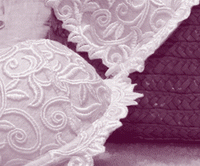Women’s bra has long and very curious history
The invention of a brassiere, commonly referred to as a bra, was immensely important in terms of women’s health. The bra liberated women from the corset which had inflicted irrevocable damage to health over the course of many centuries. It is rather difficult to tell when exactly this most popular form of underwear for the upper body was invented. The point is that the bra has been invented for several times over the history of mankind. Women have used various garments to cover or restrain their breasts from time immemorial. Women’s torsos depicted on several archeological finds look completely naked. On the other hand, brassiere-like “covers” for the breasts were unearthed during the excavation of burial grounds in the vicinity of Susa. However, there is no evidence that the article of clothing was worn by women on a regular basis at the time. Perhaps the garment was a part of the formal attire for the burial rite.

Crete
At about 2100 BC, women wore an underbodice, which elevated the breasts without covering them. Pieces of leather attached to the garment were meant to trim the silhouette and enhance the appearance of breasts. Some experts believe the first corset was built in the same period.
Egypt
Egyptian women wore a kind of work blouse in the second century BC. The garment was designed to emphasize the beauty of the bust without actually covering it.
Greece
Greek women used a corset laced up to the breasts, which were left naked. Women were banned from wearing the corset and crinoline, and therefore they wore apodesme, a band of fine material tied around the torso for supporting the breasts during movement. A narrower variety of apodesme, called mastodeton, came into use in later times. There were other varieties of the garment under different names associated with parts of the body on which the garment was fixed.
Rome
Roman women apparently borrowed apodesme from their Greeks, and changed the names of it into mamillare, fascia, capitium, and toenia. Girls were supposed to wear fascia to curb the growth of breasts. Mamillare were used by busty ladies. The sole purpose of storphium was to provide support of the breasts.
France
One of the frescos on the Arch of Triumph in Paris depicts a group of Gallic women wearing nothing but long skirts. Women of Gallia began wearing bando only after Julius Caesar conquered their country.
Basqine or a skirt pertaining to the national costume of Basque women came into fashion in the 12th century. The skirt is a variety of a close-fitting corset made of stiff fabric to support the waist. A bodice or gourgandine was worn on top of the corset in the 13th century.
According to the so-called Strasbourg decree issued in 1370, all women “must support their breasts by means of an undershirt or a laced-up dress.”
A triangular piece of fabric and a semitransparent gauzy kerchief was worn around the upper torso during the reign of Carl VII, while the corset was thought to be too tight to wear and detrimental to the ribcage. Ambrose Paret was the first one to notice that wearing a corset could lead to the deformation of ribs, and therefore cause serious damage to lungs.
The corset quickly fell out of fashion following the 1789 French Revolution. Women seemed to respond enthusiastically to some philosophical and aesthetic ideas popular at the time e.g. imitation of customs dating back to the days of antiquity, and the thesis by Jean Jacques Rousseau about going back to nature. A scarf tied under the thorax supported the breasts.
The “a la Ninon” corset was much in fashion in the time of Napoleon I.
The bra was invented several times. The first garment looking more or less like a typical bra was developed by the French corset maker Ermine Cadolle in 1889. The bra was dubbed “le Bien-Etre,” (“well-being” in English), and consisted of two cups for the breasts and two satin running around the torso. It also had a hook fastener at the back for attaching the device to a corset.
The 20th century, especially a period following World War I, brought out the liberalization of morals. Women feel very comfortable wearing contemporary clothes. Softer materials were more frequently used for the manufacture of corsets, which were eventually superseded by the bando in the shape of a bra used by women in antiquity. In 1932, the shape of a bra was changed so as to shift the emphasis to the depth of the cups. Some great fashion designers e.g. Paul Poiret would later introduce the bra as an article of lingerie, and women would be recommended to wear it right next to the bare skin.
United States
At the beginning the bra was not so popular with American women. In 1913, Mary Phelps Jacobs, a direct descendant of Robert Fulton (the inventor of a steamboat), told her maid to sew together two handkerchiefs and two pink ribbons to make a bra. In fact, the bra consisted of elastic bands 3-10 cm wide, whose number was variable depending on the circumference of the chest under the bust. Jacobs called the invention a “backless brassiere” and patented it in 1915. The bra did not sell well at the beginning. However, Jacob’s third husband happened to work for a corset company. The company owners showed a lot of interest in the novelty. Eventually, the company bought the invention for $15 thousand, a large sum of money at the time. The “original American bra” was valued at $15 million many years later.
The design of the bra has been gradually improved. Breast pads or “falsies” were invented in 1935. Breast pads are designed for wearing between the breast and the bra to give the appearance of larger breasts. The cup size measurement system given by a letter of the alphabet starting from A to D was adopted in the same period.
Adjustable shoulder straps came into being in 1942. The first museum of lingerie was opened in the U.S. in 1986. A push-up bra that is focused on shaping the bust and cleavage was developed in 1992-1994. The invention was dubbed Wonderbra by Vogue magazine.
A wide range of styles of brassieres now exists, to be worn in a variety of situations, and with a variety of outergarments. Fashion designers have come up with quite a few ideas over the last several years. Some of the latest novelties include a seamless bra covering the body like the second skin; an electrnic bra to be worn during mammography, and a maternity bra designed for facilitating access to the nipple.
Translated by Guerman Grachev
Pravda.ru
Subscribe to Pravda.Ru Telegram channel, Facebook, RSS!



